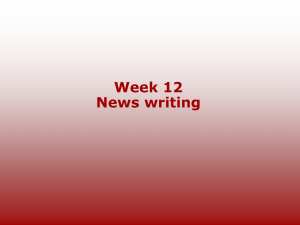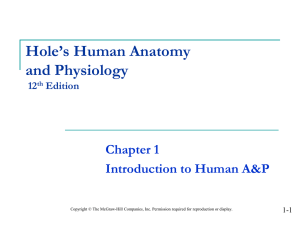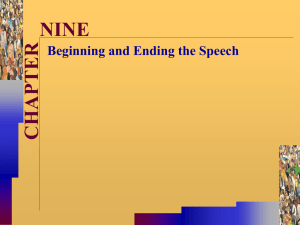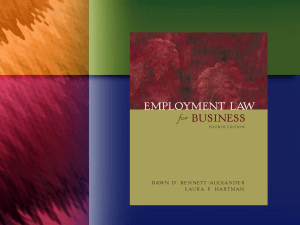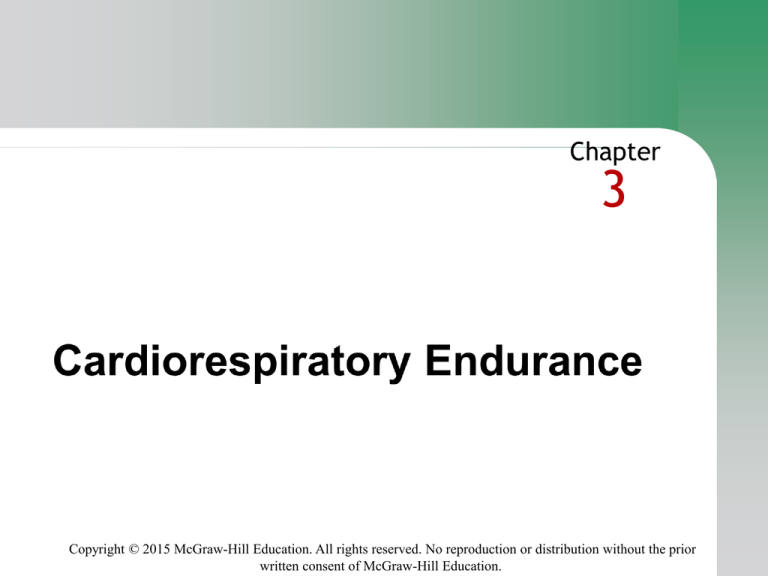
Chapter
3
Copyright © 2015 McGraw-Hill Education. All rights reserved. No reproduction or distribution without the prior
written consent of McGraw-Hill Education.
Basic Physiology of
Cardiorespiratory Endurance Exercise
Benefits of Cardiorespiratory Exercise
Assessing Cardiorespiratory Fitness
Developing a Cardiorespiratory Endurance Program
Exercise Safety and Injury Prevention
Copyright © 2015 McGraw-Hill Education. All rights reserved. No reproduction or distribution without the prior
written consent of McGraw-Hill Education.
3-2
Cardiorespiratory system: system
that circulates blood through the
body; consists of the heart, blood
vessels, and respiratory system
Copyright © 2015 McGraw-Hill Education. All rights reserved. No reproduction or distribution without the prior
written consent of McGraw-Hill Education.
3-3
The heart
Fist-sized muscle with four chambers
Pulmonary circulation: circulatory
system that moves blood between
the heart and the lungs; controlled
by the right side of the heart
Systemic circulation: circulatory
system that moves blood between the
heart and the rest of the body;
controlled by the left side of the heart
Copyright © 2015 McGraw-Hill Education. All rights reserved. No reproduction or distribution without the prior
written consent of McGraw-Hill Education.
3-4
The heart
Waste-laden, oxygen-poor blood
travels through venae cavae, into the
heart’s right upper changer, or atrium
After the right atrium fills, it
contracts and pumps blood into the
heart’s right lower chamber, or ventricle
▪ Venae cavae: The large veins
through which blood is returned
to the right atrium of the heart
Copyright © 2015 McGraw-Hill Education. All rights reserved. No reproduction or distribution without the prior
written consent of McGraw-Hill Education.
3-5
The heart
Atrium: The right upper chamber
of the heart in which blood collects
before passing to the ventricles (pl atria)
Ventricle: right lower chamber of heart
from which blood flows through arteries
to the lungs and other parts of the body
Diffusion: process of oxygen moving
from lungs to the blood and carbon
dioxide moving from blood to the lungs
Copyright © 2015 McGraw-Hill Education. All rights reserved. No reproduction or distribution without the prior
written consent of McGraw-Hill Education.
3-6
The heart
Aorta: The body’s large artery;
receives blood from the left ventricle
and distributes it to the body
Systole: Contraction of the heart
Diastole: Relaxation of the heart
Blood pressure: The force exerted
by the blood on the walls of the
blood vessels; created by the
pumping action of the heart
Copyright © 2015 McGraw-Hill Education. All rights reserved. No reproduction or distribution without the prior
written consent of McGraw-Hill Education.
3-7
Copyright © 2015 McGraw-Hill Education. All rights reserved. No reproduction or distribution without the prior
written consent of McGraw-Hill Education.
3-8
Blood vessels
Blood vessels classified
by size and function
▪ Veins: Vessels that carry
blood to the heart
▪ Arteries: Vessels that carry
blood away from the heart
Copyright © 2015 McGraw-Hill Education. All rights reserved. No reproduction or distribution without the prior
written consent of McGraw-Hill Education.
3-9
Blood vessels
Endothelial cells: Cells
lining the blood vessels
Nitric oxide: A gas released by the
endothelial cells to promote blood flow
Capillaries: Very small blood vessels that
distribute blood to all parts of the body
Coronary arteries: Pair of large blood
vessels that branch off aorta and supply
the heart muscle with oxygenated blood
Copyright © 2015 McGraw-Hill Education. All rights reserved. No reproduction or distribution without the prior
written consent of McGraw-Hill Education.
3-10
The Respiratory System
Respiratory system: The lungs, air
passages, and breathing muscles;
supplies oxygen to the body
and removes carbon dioxide
Alveoli: Tiny air sacs in the lungs that
allow the exchange of oxygen and carbon
dioxide between the lungs and blood
Copyright © 2015 McGraw-Hill Education. All rights reserved. No reproduction or distribution without the prior
written consent of McGraw-Hill Education.
3-11
The Cardiorespiratory System
at rest and during exercise
At rest, your heart beats at a rate of
about 50 to 90 beats per minute, and you
take about 12 to 20 breaths per minute
▪ Stroke volume: amount of blood
the heart pumps with each beat
▪ Cardiac output: amount of blood
pumped by the heart each minute; a
function of heart rate and stroke volume
Copyright © 2015 McGraw-Hill Education. All rights reserved. No reproduction or distribution without the prior
written consent of McGraw-Hill Education.
3-12
Metabolic rate: rate at
which body uses energy
Energy from food
Carbohydrates, fats, and proteins
▪ Glucose: Simple sugar that circulates in blood
and is used by cells to fuel ATP production
▪ Glycogen: Complex carbohydrate stored in
the liver and skeletal muscles; the major fuel
source during most forms of intense exercise
▪ Glycogen is the storage form of glucose
Copyright © 2015 McGraw-Hill Education. All rights reserved. No reproduction or distribution without the prior
written consent of McGraw-Hill Education.
3-13
ATP (adenosine triphosphate):
the energy “currency” of cells
Adenosine triphosphate (ATP):
Energy source for cellular processes
Cells store small amount of ATP
When they need more, they create it
through chemical reactions using body’s
stored fuels—glucose, glycogen, and fat
Copyright © 2015 McGraw-Hill Education. All rights reserved. No reproduction or distribution without the prior
written consent of McGraw-Hill Education.
3-14
Immediate
(“explosive”)
energy system:
Supplies energy
to muscle cells
through breakdown
of cellular stores of
ATP and CP
Copyright © 2015 McGraw-Hill Education. All rights reserved. No reproduction or distribution without the prior
written consent of McGraw-Hill Education.
3-15
Nonoxidative (anaerobic)
energy system: Supplies energy
to muscle cells through breakdown
of muscle stores of glucose and
glycogen; also called the anaerobic
system or the lactic acid system
Anaerobic: Occurring in
the absence of oxygen
Lactic acid: Metabolic acid resulting from
the metabolism of glucose and glycogen
Copyright © 2015 McGraw-Hill Education. All rights reserved. No reproduction or distribution without the prior
written consent of McGraw-Hill Education.
3-16
Oxidative (aerobic) energy system:
Supplies energy to cells through
breakdown of glucose, glycogen, and
fats; also called the aerobic system
Aerobic: Dependent on
the presence of oxygen
Mitochondria: Cell structures
that convert the energy in
food to a form the body can use
Copyright © 2015 McGraw-Hill Education. All rights reserved. No reproduction or distribution without the prior
written consent of McGraw-Hill Education.
3-17
Maximal oxygen consumption
(VO2max): Highest rate of oxygen
consumption an individual is capable
of during maximum physical effort,
reflecting the body’s ability to
transport and use oxygen; measured
in milliliters of oxygen used per
minute per kilogram of body weight
Copyright © 2015 McGraw-Hill Education. All rights reserved. No reproduction or distribution without the prior
written consent of McGraw-Hill Education.
3-18
The energy system in combination
Intensity and duration of
exercise determines which
energy system predominates
Physical fitness and energy production
Fitness program should target energy
system most important to your goals
Cardiorespiratory system is
the key to overall fitness
Copyright © 2015 McGraw-Hill Education. All rights reserved. No reproduction or distribution without the prior
written consent of McGraw-Hill Education.
3-19
Cardiorespiratory
endurance exercise
helps the body:
Become
more efficient
Cope better with
physical challenges
Resist chronic diseases
Copyright © 2015 McGraw-Hill Education. All rights reserved. No reproduction or distribution without the prior
written consent of McGraw-Hill Education.
3-20
Copyright © 2015 McGraw-Hill Education. All rights reserved. No reproduction or distribution without the prior
written consent of McGraw-Hill Education.
3-21
Endurance exercises
enhance heart health:
Maintaining or increasing the heart’s
blood and oxygen supply
Improving the heart muscle’s function
Strengthening the heart’s contraction
Increasing the heart’s cavity size
Increasing blood volume
Reducing blood pressure
Copyright © 2015 McGraw-Hill Education. All rights reserved. No reproduction or distribution without the prior
written consent of McGraw-Hill Education.
3-22
Regular endurance exercise
improves metabolism
Increases
capillaries in muscles
Allows training
muscles to make the
most of oxygen and fuel
Increases mitochondria
Prevents glycogen depletion
Copyright © 2015 McGraw-Hill Education. All rights reserved. No reproduction or distribution without the prior
written consent of McGraw-Hill Education.
3-23
Cardiovascular Diseases
Cancer
Type 2 Diabetes
Osteoporosis
Inflammation
▪ Inflammation: body’s response to tissue and
cell damage, environmental poisons, or poor
metabolic health
Deaths from all causes
▪ Physically fit people have
reduced risk of dying prematurely
Copyright © 2015 McGraw-Hill Education. All rights reserved. No reproduction or distribution without the prior
written consent of McGraw-Hill Education.
3-24
Regular exercise increases
daily calorie expenditure
Exercise increases resting metabolic rate
Improved immune function
Immune system: The physiological
processes that protect us from diseases
such as colds, bacterial infections, and
even cancer
Exercise increases immune function
Copyright © 2015 McGraw-Hill Education. All rights reserved. No reproduction or distribution without the prior
written consent of McGraw-Hill Education.
3-25
SOURCE: Wen, M, et al 2013 Physical activity and mortality
among middle-aged and older adults in the United States
Journal Physical Activity & Health Published online
Copyright © 2015 McGraw-Hill Education. All rights reserved. No reproduction or distribution without the prior
written consent of McGraw-Hill Education.
3-26
Performing physical activities provides
proof of skill mastery and self-control
Endurance exercises lessen anxiety,
depression, stress, anger, and hostility,
while improving sleep
Copyright © 2015 McGraw-Hill Education. All rights reserved. No reproduction or distribution without the prior
written consent of McGraw-Hill Education.
3-27
The 1-Mile Walk Test
Estimates level of maximal oxygen
consumption based on time it takes to
complete one mile of brisk walking and
the heart rate at the end of the walk
The 3-Minute Step Test
Measures how long it takes the
pulse to return to normal after
three minutes of stepping exercise
Copyright © 2015 McGraw-Hill Education. All rights reserved. No reproduction or distribution without the prior
written consent of McGraw-Hill Education.
3-28
The 15-Mile Run-Walk Test
Oxygen consumption increases with speed
The Beep Test
A prerecorded series of tones sound off
at faster and faster intervals, and the
exerciser must keep up with the beeps
Monitoring Your Heart Rate
Measure your heart rate using a heart
rate monitor or counting your pulse beats
Interpreting Your Score
Copyright © 2015 McGraw-Hill Education. All rights reserved. No reproduction or distribution without the prior
written consent of McGraw-Hill Education.
3-29
Copyright © 2015 McGraw-Hill Education. All rights reserved. No reproduction or distribution without the prior
written consent of McGraw-Hill Education.
3-30
Set realistic goals
Set starting frequency,
intensity, and duration of
exercise at appropriate levels
Choose suitable activities
Warm up and cool down
Adjust program as fitness improves
Copyright © 2015 McGraw-Hill Education. All rights reserved. No reproduction or distribution without the prior
written consent of McGraw-Hill Education.
3-31
Set “SMART” goals
Specific
Measurable
Attainable
Realistic
Time frame-specific
Copyright © 2015 McGraw-Hill Education. All rights reserved. No reproduction or distribution without the prior
written consent of McGraw-Hill Education.
3-32
Frequency of Training
Experts recommend 3 to 5 days per week
Intensity of Training
Target heart rate zone: Heart rates that
should be reached and maintained during
cardiorespiratory endurance exercise to
obtain training effects
▪ Heart rate reserve: Difference between
maximum heart rate and resting heart rate
Copyright © 2015 McGraw-Hill Education. All rights reserved. No reproduction or distribution without the prior
written consent of McGraw-Hill Education.
3-33
Intensity of training
MET: Unit of measure that represents
body’s resting metabolic rate
Ratings of perceived exertion (RPE):
System of monitoring exercise intensity
based on assigning a number to the
subjective perception of target intensity
Talk test
Copyright © 2015 McGraw-Hill Education. All rights reserved. No reproduction or distribution without the prior
written consent of McGraw-Hill Education.
3-34
Time (duration) of training
Total duration of 20 to 60
minutes per day recommended
Type of activity
Cardiorespiratory endurance
exercises include activities that
involve rhythmic use of large muscle
groups for an extended period of time
Copyright © 2015 McGraw-Hill Education. All rights reserved. No reproduction or distribution without the prior
written consent of McGraw-Hill Education.
3-35
SOURCE: Pick, H L, ed 1978
Psychology from Research to
Practice Kluwer Academic/Plenum
Publishing Corporation With kind
permission of Springer Science and
Business Media and the author
Copyright © 2015 McGraw-Hill Education. All rights reserved. No reproduction or distribution without the prior
written consent of McGraw-Hill Education.
3-36
Copyright © 2015 McGraw-Hill Education. All rights reserved. No reproduction or distribution without the prior
written consent of McGraw-Hill Education.
3-37
Copyright © 2015 McGraw-Hill Education. All rights reserved. No reproduction or distribution without the prior
written consent of McGraw-Hill Education.
3-38
Copyright © 2015 McGraw-Hill Education. All rights reserved. No reproduction or distribution without the prior
written consent of McGraw-Hill Education.
3-39
Copyright © 2015 McGraw-Hill Education. All rights reserved. No reproduction or distribution without the prior
written consent of McGraw-Hill Education.
3-40
Copyright © 2015 McGraw-Hill Education. All rights reserved. No reproduction or distribution without the prior
written consent of McGraw-Hill Education.
3-41
Warm-up session should
include low-intensity, whole
body movements similar to those
in the activity that will follow
Do not use stretching as part
of pre-exercise warm-up
Cooling down returns the
body to a non-exercising state
Copyright © 2015 McGraw-Hill Education. All rights reserved. No reproduction or distribution without the prior
written consent of McGraw-Hill Education.
3-42
You must increase the intensity,
frequency, and duration of
exercise carefully to avoid
injury and overtraining
Keep an exercise log or training diary
Maintaining cardiorespiratory fitness
Cross-training: Alternating two
or more activities to improve
a single component of fitness
Copyright © 2015 McGraw-Hill Education. All rights reserved. No reproduction or distribution without the prior
written consent of McGraw-Hill Education.
3-43
Hot weather and heat stress
Dehydration: Excessive loss of body fluid
Heat cramps: Sudden muscle
spasms and pain associated with
intense exercise in hot weather
Heat exhaustion: Illness
resulting from exertion in hot weather
Heatstroke: A severe and often fatal heat
illness characterized by significantly
elevated core body temperature
Copyright © 2015 McGraw-Hill Education. All rights reserved. No reproduction or distribution without the prior
written consent of McGraw-Hill Education.
3-44
SOURCE: Casa, D J, et al April–June 2000 National Athletic
Trainers’ Association position statement: Fluid replacement for
athletes Journal of Athletic Training 35(2): 212–224, 224a
Copyright © 2015 McGraw-Hill Education. All rights reserved. No reproduction or distribution without the prior
written consent of McGraw-Hill Education.
3-45
Cold weather
Hypothermia: Low body temperature
due to exposure to cold conditions
Frostbite: Freezing of body
tissues characterized by pallor, numbness,
and a loss of cold sensation
▪ Wind chill: Measure of how cold it
feels based on the rate of heat loss from
exposed skin caused by cold and wind
Poor air quality
Copyright © 2015 McGraw-Hill Education. All rights reserved. No reproduction or distribution without the prior
written consent of McGraw-Hill Education.
3-46
Consult a physician for the following:
Head and eye injuries
Possible ligament injuries
Broken bones
Internal disorders such as chest pain,
fainting, and heat intolerance
Copyright © 2015 McGraw-Hill Education. All rights reserved. No reproduction or distribution without the prior
written consent of McGraw-Hill Education.
3-47
Managing minor exercise injuries
For cuts and scrapes, stop the
bleeding and clean the wound
For injuries to muscles
and joints, use RICE
▪
▪
▪
▪
Rest
Ice
Compression
Elevation
Copyright © 2015 McGraw-Hill Education. All rights reserved. No reproduction or distribution without the prior
written consent of McGraw-Hill Education.
3-48
Preventing injuries
▪ Train regularly and stay in condition
▪ Gradually increase the intensity,
duration, or frequency of workouts
▪ Avoid or minimize
high-impact activities
▪ Get proper rest between
exercise sessions
▪ Drink plenty of fluids
▪ Warm up thoroughly before
you exercise and cool down afterward
Copyright © 2015 McGraw-Hill Education. All rights reserved. No reproduction or distribution without the prior
written consent of McGraw-Hill Education.
3-49
Preventing injuries
▪ Achieve and maintain a normal
range of motion in your joints
▪ Use proper body mechanics
▪ Don’t exercise when
you are ill or overtrained
▪ Use proper equipment
▪ Don’t return to your normal exercise
program until athletic injuries have healed
Copyright © 2015 McGraw-Hill Education. All rights reserved. No reproduction or distribution without the prior
written consent of McGraw-Hill Education.
3-50

